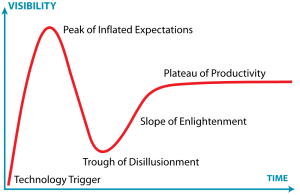Why AI Adoption Is Slowing Down—and How Effective Training Can Bridge the Gap
Despite the buzz about AI’s potential, many businesses hesitate to embrace it fully. Beyond Silicon Valley’s investment surge, a sense of disillusionment is growing.
So, what’s causing this hesitation, and how can we address it? As an AI trainer and consultant, I’ve seen these challenges firsthand in the workshops and seminars I’ve run.
Let’s examine the key reasons behind the slowdown and explore how targeted training can help you unlock the true power of AI.
Table of Contents
The AI Adoption Rollercoaster: The “Trough of Disillusionment”
The tech industry loves hype cycles. Gartner describes a typical pattern: excitement leads to inflated expectations, followed by a “trough of disillusionment” when reality sets in.

We seem to be entering this trough with AI. Businesses are grappling with managing expectations, identifying relevant use cases, and achieving a clear return on their AI investments.
While startups and tech giants pour billions into AI, non-technical businesses—especially SMEs—are becoming cautious. Confusion, complexity, and a lack of clear use cases are major roadblocks. In Ireland, this hesitation is particularly evident, with businesses lagging in AI adoption across various sectors.
Why AI Tools Aren’t as Easy as They Seem
A significant barrier to AI adoption is that AI tools often work in unexpected ways. They require a deeper understanding to unlock their potential. Effective training should cover understanding different AI models, prompt engineering techniques, preparing data, and navigating ethical considerations.
Ethan Mollick, a Wharton professor, emphasizes the importance of hands-on experience with AI:
“My rule of thumb is that you need about 10 hours with a frontier model to get your hands around it.”
Spending this time allows you to move beyond surface-level interactions and see real value from AI.
Overwhelm Leads to Inaction
Another obstacle is the sheer scope of AI’s potential. Hearing that “you can use AI for anything” sounds promising, but it can be overwhelming.
Imagine sitting in front of ChatGPT, faced with a blank input box and told, “You can use it for anything.” The vast possibilities can be paralyzing. Many new users don’t know where to begin. This creates analysis paralysis.
The popularity of “structured prompts” adds another layer of complexity. While helpful for experienced users, these pre-built prompts can intimidate beginners. You might think, “How can I ever create something this complex?” The learning curve feels steep.
Tailoring AI to Your Business Needs
Even with basic AI training, businesses often struggle to translate knowledge into practical applications. It’s not enough to know how to use AI tools; you need to understand how they fit into your specific processes.
To bridge this gap, conduct a thorough audit to pinpoint where AI can automate tasks, streamline workflows, improve efficiency, or enhance decision-making.
Identify tasks where AI can add the most value. For instance, automating repetitive tasks like data entry or routine customer inquiries can free up your team for more strategic work.
Practical Steps to Drive AI Adoption
To overcome the challenges of AI adoption, you need a structured approach. Here’s how to get started:
- Start Small: Begin with a manageable AI project that can deliver quick wins. This could involve automating a specific task like invoice processing or improving sales forecasting accuracy.
- Experiment and Learn: AI adoption is an ongoing process. Be willing to experiment, learn, and adapt your approach. Regularly analyse data to measure impact and identify areas for improvement.
- Build AI Literacy Across Teams: AI training shouldn’t be limited to IT departments. Employees in various roles can benefit from understanding how AI tools work. Implement training formats like workshops, online courses, or mentoring to cater to different learning styles. Building AI literacy across your organisation encourages wider adoption and ensures AI is used effectively.
Overcoming the Fear of AI: Transforming Roles, Not Replacing Them
Many worry that AI will replace jobs. The reality is more nuanced.
AI doesn’t necessarily eliminate jobs; it transforms them. By automating mundane tasks, AI allows employees to focus on higher-value work that requires human creativity and problem-solving.
In customer service, AI chatbots can handle routine inquiries, freeing up representatives to address more complex issues. In marketing, AI can personalise customer experiences at scale, allowing marketers to focus on creative strategies.
But this shift requires proper training. If you don’t invest in training, you risk underutilising AI and creating fear among your workforce.
Early AI Adoption Creates a Competitive Edge
While some sectors are experiencing a slowdown, businesses that embrace AI strategically are gaining a competitive edge. AI is boosting productivity, enhancing decision-making, and streamlining operations.
To unlock AI’s full potential, you need to equip your team with the right knowledge and hands-on experience. By investing in targeted AI training, you can overcome adoption challenges and position your business for success.
If you’re ready to explore how AI can transform your business but unsure where to start, let’s have a conversation. We can discuss your specific needs and develop a tailored training program to help you harness the power of AI.
Don’t hesitate to reach out and schedule a call—the sooner you begin your AI journey, the better positioned you’ll be for the future.




